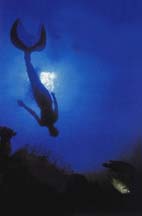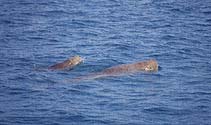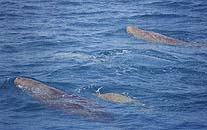by Peter Vine
Pictures by Peter Vine and Hans Sjoeholm
 Habitation sites at Umm an Nar island, forming part of today's burgeoning metropolis of Abu Dhabi, confirm that over four thousand years ago the inhabitants of the Gulf coastline hunted sea-cows with a considerable degree of success. At an archaeological site excavated on the island, dugong bones are more frequent than those of dromedary, ox, oryx, gazelle, or goat.
Habitation sites at Umm an Nar island, forming part of today's burgeoning metropolis of Abu Dhabi, confirm that over four thousand years ago the inhabitants of the Gulf coastline hunted sea-cows with a considerable degree of success. At an archaeological site excavated on the island, dugong bones are more frequent than those of dromedary, ox, oryx, gazelle, or goat.
Just how numerous these reclusive creatures once were is a matter for conjecture. We can however turn to a few ancient texts for actual descriptions of where dugongs once lived in Arabian waters. A text written in the second century BC by Agatharchides of Cnidos (translated by Stanley Burnstein), describing a section of Red Sea coastline, reads as follows: "......the sea is so shallow that it measures not more than two fathoms. Everywhere it is green, not because of the nature of the waters but because of the seaweed and other vegetation that is visible through the water. For this reason innumerable sea dogs are found there...." When Burnstein made this translation from the more than 2000 year old text, he identified the region being described as the vast shallow sea-grass bed region south of the picturesque port of Suakin on the western coastline of the Red Sea. To this day this region harbours small families of dugongs (it was here that I experienced my first Red Sea underwater encounter with one) and there seems little doubt that the Greeks were quite familiar with the animal.
Such literary excursions into Arabia's past can uncover some real gems of information. Another marine mammal that once inhabited these seas was hunted to extinction before enlightened modern day conservationists even had the opportunity to set eyes on it. Like the dugong it was once so abundant that herds of several thousand individuals were observed. This Red Sea seal, for that is what it was, is unknown from fossil records and has left no physical trace. The most recent record is by J.R. Wellsted, writing in Travels in Arabia in 1838, who stated that he had seen the skin of a young seal captured near Ras Banas and that local people told him that seals were still common in the region. Once again, we can turn back more than two thousand years, to the descriptive writings of Agatharchides who lived at a time when seals were a common sight in the Red Sea: " The people who live near the never thirsty Fisheaters, as though an unbreachable treaty had been concluded between them and the seals, do not harass the seals, nor are they harmed by them. Without plotting against one another, each group strictly respects the other's prey, and, thus, they live in close association with one another in a way that would be difficult to parallel among men who live with other men". Would that such harmony between Man and wildlife existed today! Incidentally seals were so numerous in the northern Red Sea at this time that what we know today as Tiran island was known to the ancient Greeks as 'Seal Island'!
For some time it has looked as if the dugong was heading on the same road to regional extinction as the long lost Red Sea seal. There is little doubt that their numbers have been in decline for several hundred years and probably much longer. As recently as ten years ago it was widely thought that dugongs were all but extinct in Arabian waters with the few surviving individuals likely to disappear within a few years. Scientists looked back with anguish at how the animal had until recently been quite numerous. The dugong seemed to be a timid and shy marine mammal that was surviving "by the skin of its tusks". Few westerners had ever seen them alive and when dead specimens were washed up they still caused great excitement in the media, with claims that the legendary mermaid had been found: "Half Man, Half Fish!", read the headlines.
One western observer who experienced much more than a fleeting glimpse of these fascinating animals was William Travis who described his fascinating encounter in his book: Voice of the Turtle. To the sceptical scientists who had only seen their bones in museums Travis' description seemed to verge on the fanciful for, according to him, not only had he seen them but he had played with them in the shallows. Travis was working as a fisheries officer off the Somalian coastline and encountered a large herd of dugongs close to where fishermen had set nets. In an effort to avoid a wholesale slaughter with them drowning in the nets, Travis set out to physically lead the sea-cows away from the fishing area. " So I decided to 'herd' these great browsers, to turn them south to our area, and for the next ten days two boats were deployed on this task. During this time I learnt much concerning their lives, most of which was at complete variance with what I had read. Many authorities regard the Dugong as an inhabitant of swamp and estuary, shunning the open sea and existing only in backwaters and in small family groups. Yet here, off the open coast, with the swamp 300 miles to the south, I found huge herds, sometimes as many as 500 strong, swimming freely within and without the reef. They were neither elusive nor shy; being great dumb sea-oxen that only responded when you whacked their backs with a paddle, blew conch shell-horns, or clapped the water with oar blades. During the afternoon the young calves of up to 4 feet long would leave the herd and form a nursery close to the sandy beaches. Here they would play like slow, clumsy puppies. Wading amongst them, they would dive between my legs, brush against my side and generally use me as a pivot point and scratching post."
Such descriptions of huge numbers of approachable sea-cows seemed to many scientists to be out of keeping with what little was known about the animal and as Travis rightly pointed out, his observations of their behaviour differed markedly from the accepted view. Whilst marine biologists were correct in reporting their shyness when in small groups, it was also clear that they sometimes aggregated into much larger herds and they seemed to show much less fear of boats or humans when they were in these herds.
For years, fishermen in the southern Gulf have harvested dugongs which became accidentally caught in their fishing nets. It was more a case of making good use of an unexpected catch than actually hunting them. Wilfred Thesiger, writing in his epic book Arabian Sands, observed one such capture. " ...Once they brought in a young dugong or sea-cow they had caught in their nets. It was about four feet long, a pathetically helpless-looking creature, hideously ugly. They said its meat was good eating, and that its skin made sandals." Every year fishermen, beach-walkers and marine biologists would encounter a few carcasses washed up along the shoreline and when major oil-spills occurred, as for example the one known as the Nowruz spill during the Iran-Iraq war, biologists were on the look out for any sudden increase in the occurrence of dead dugongs that had been killed by the oil.
It was one such survey, conducted by Saudi Arabian and expatriate biologists, with cooperation of neighbouring Arabian countries, that caused one of the biggest stirs ever among marine-mammal conservationists. At the height of the survey into potential damage related to oil-spills in the Gulf, at a time when biologists were more familiar with dead dugongs than live ones (at least 37 had been killed by the 1983 Nowruz spill), the team carrying out the survey came across two densely packed adjacent herd of 577 and 97 sea-cows respectively within an area of less that 1 sq.km, and upped the total population estimate of the Gulf from 'a few hundred' to 7,310 ± 1,300.
One of the interesting things about this sighting of dugongs in the sea between Bahrain and Qatar was that, despite the very large numbers present in the aggregations, which incidentally represented the largest dugong herds ever recorded, there were hardly any other sightings of dugongs within this region. It seemed that it was an open-invitation party at which every dugong worth his salt attended.
Since this dramatic sighting, and the completion of the comprehensive survey of the Status and Conservation of Dugongs in the Arabian Region (published by MEPA and Ministry of Defence & Aviation, Saudi Arabia in 1989), biologists and regional authorities have become more aware of the Gulf's important population of dugongs. During the massive oil-spill that was triggered by Iraq's invasion of Kuwait there were once more heightened fears that the oil would reach an area where the dugongs aggregate and possibly kill a large number of these defenceless marine mammals. Fortunately this did not happen.
Although we now know that the dugongs are out there in quite significant numbers, they remain an elusive quarry for film-makers, divers and nature-watchers. Two people who have done their best to build up a picture of their seasonal behaviour in Bahraini waters are Dr Mike and Cathy Hill. Their own story of just how frustrating this has been is told in the second half of this special feature.
IN SEARCH OF DUGONGS (Part 2)
Text and pictures by Mike and Kathy Hill
 It was the 12th of February 1992. We were bobbing around in a small motor-boat in the Arabian Gulf. Kathy was on the telephone to London, England!
It was the 12th of February 1992. We were bobbing around in a small motor-boat in the Arabian Gulf. Kathy was on the telephone to London, England!
Throughout the previous year we had been taking weekly helicopter flights (courtesy of Bahrain's Public Security Air Wing) over Bahrain's coastal waters in search of dugongs. The objective was to record the sea-cows on film, from both above and below water, for a film on Bahrain's natural history that was being made with our cooperation by Oxford Scientific Films. Despite lengthy searches our tally to date was just two dugongs that we had seen off the south coast of Bahrain.
We had received numerous reports from both fishermen and pleasure boaters of sightings of these unusual animals but suspected that many of these referred to hump-back dolphins which are quite common in these waters. A dead adult dugong, washed up south of Askar village, did however help to sustain our severely tested faith in the existence of the elusive herds that had been previously reported.
It was a pure hunch that led us to charter the small boat that had brought us from Bahrain Yacht Club to this area south of Fasht al Adhm, between the main island coastline and the small island of Um Jalid.
It is quite frankly hard to understand how dugongs were ever mistaken for mermaids. Their bodies are cigar-shaped, covered in smooth grey skin. The dorso-ventrally flattened rear end terminates in a tail fluke not too dissimilar to that of a dolphin. This is in striking contrast to their relatives, the manatees, which have spatulate tails. There are no signs of the mammalian hind limbs and the front limbs comprise a pair of paddle-like flippers. When dugongs break surface they breathe in fresh air through their valve-like nostrils situated at the tip of their short, broad, trunk-like snout. The flattened bristly muzzle is turned downwards in keeping with its bottom-feeding behaviour.
Although the dugong is widely distributed throughout the coastal waters of the western Pacific and tropical Indian ocean, its population is extremely patchy within this range. One explanation for this may be the impact of man through hunting, habitat destruction or other disturbances. Within the Gulf region dugong are still found in Saudi Arabian, Bahraini, Qatari and UAE waters. Since the survey conducted in 1986 (see previous article) no further population studies have been undertaken, despite the fact that this reclusive marine mammal is vulnerable or endangered throughout its range and the Arabian population represents a vital part of the world-population.
 Our boat had brought us through a slightly choppy sea on what had turned out to be a fine sunny day. Our elation, and Kathy's telephone call, were triggered by the sight of numerous steely grey bodies surging through the water approximately two hundred metres ahead of the boat. Our binocular gaze, their manner of movement through the water and gut feeling told us that they could only be dugongs. At last we had found what we had spent so long searching for and while the mermaid may be a myth of our imagination, the dugong herds about which we had read were clearly fact, not fiction. It soon became apparent that we were moving through a herd of about one hundred and fifty individuals. They were mainly adults but a few calves were also clearly visible, cruising close to the adult's torpedo like bodies.
Our boat had brought us through a slightly choppy sea on what had turned out to be a fine sunny day. Our elation, and Kathy's telephone call, were triggered by the sight of numerous steely grey bodies surging through the water approximately two hundred metres ahead of the boat. Our binocular gaze, their manner of movement through the water and gut feeling told us that they could only be dugongs. At last we had found what we had spent so long searching for and while the mermaid may be a myth of our imagination, the dugong herds about which we had read were clearly fact, not fiction. It soon became apparent that we were moving through a herd of about one hundred and fifty individuals. They were mainly adults but a few calves were also clearly visible, cruising close to the adult's torpedo like bodies.
Now we were truly in the midst of the herd. They were surfacing and exhaling all around the boat, some even crossing directly in front of our bows. Their backs were distinctively marked with deep scars and it was tempting to conjecture that these were the result of propeller injuries but we knew that this was quite unlikely since they are so rarely reported by fishermen that it seems doubtful that they would have much close contact with their boats.
While Kathy spoke to the film producer from her portable telephone, enthusiastically describing our exciting encounter with so many dugongs, we remained with the herd. For approximately an hour we watched mesmerised as the sea-cows swam around our boat, apparently unafraid of us although they did not exhibit the typical curiosity of dolphins. After lingering with this herd, confident that they were not suddenly going to disappear, we decided that we should not alarm them unnecessarily. Before they tired completely of our company we quietly bid them adieu, increased our speed, and headed off in search of any other herds.
As we did so however the wind rose, throwing up a choppier sea, and making dugong-spotting almost impossible. It reached a point where every wave, seen against the light, appeared to be a dugong snout pushing through the surface of the sea. With mixed feelings of elation at the success of our long search but frustrated by our failure to find more dugongs, we returned to shore. Meanwhile wheels were turning back in London.
Within two days of Kathy's telephone call the camera crew from Britain had arrived in Bahrain. It was with more than a small degree of trepidation that she accompanied them on the helicopter on the following day. Fears that the marine mammals would have vanished into thin air proved groundless however and within twenty minutes of take-off they were circling over a group of at least fifty animals with cameraman Philip Lovel hanging so far out of the 'copter that the thought did occur that there might shortly be 51 mammals down below, one of whom did not think sea-grass was all that tasty!
The dugongs were shortly to be joined by a cameraman, but fortunately not Philip. In an operation executed with military precision, the helicopter pilot guided in our motor-boat so that the underwater cameraman could swim with the sea-cows. Unfortunately however the dugong had moved into a shallow area among the reefs just north of Um Jalid. As they swam through this area they stirred up the mud so much that the cameraman was only able to obtain views of the animals in murky water.
Time and financial restraints meant that the crew soon had to return to UK. Although we have continued to search for dugongs around Bahrain we have never again come as close as we did on that memorable day of February 12th 1992. Early this year, again in February, a herd of a hundred or so was sighted by helicopter to the south of Bahrain. It's one thing for Dugongs to have these annual parties but quite another to receive an invitation to attend!
(Editor's note: The largest herd of dugongs ever reported also occurred in these waters, in February 1986.)
Contents | News | Book Reviews | Back Issues | Subjects | Search
Arabian Wildlife. Volume 1, Number 2